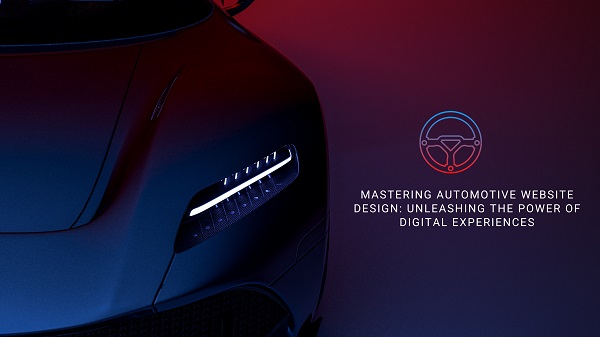In today’s digital age, an automotive website plays a pivotal role in shaping a brand’s online presence and engaging potential customers.
A well-designed website can showcase a dealership’s offerings, build trust, and ultimately drive sales.
To help you maximize the impact of your automotive website, we’ve compiled a comprehensive guide featuring expert tips, industry insights, and creative design strategies.
So fasten your seatbelt and let’s explore the world of automotive website design!
1. Understanding User Experience (UX)
A seamless user experience is the cornerstone of a successful automotive website. Consider your target audience’s needs and preferences, ensuring that your design caters to their expectations. Navigation should be intuitive, allowing users to effortlessly find the information they seek. Implement clear and logical menus, complemented by search functionality for quick access. Utilize concise and engaging copy, enhancing readability with well-structured paragraphs and bullet points.
Furthermore, optimize your website for mobile devices, as an increasing number of users browse the web on smartphones and tablets. Responsive design ensures that your website adapts to different screen sizes, maintaining a consistent user experience across all devices. By prioritizing UX, you can enhance customer satisfaction and drive conversions.
Example: Volkswagen (www.volkswagen.co.uk)
Volkswagen’s website prioritizes user experience by providing a seamless browsing experience across different devices. The site features intuitive navigation, allowing visitors to easily explore different models, access vehicle specifications, and find relevant information. The search functionality enables users to quickly locate specific details or locate nearby dealerships. Volkswagen’s website is optimized for mobile devices, ensuring a smooth experience for users on smartphones and tablets. With a focus on user experience, Volkswagen delivers a website that caters to the needs and preferences of its target audience.
2. Captivating Visual Design
Appealing visuals can captivate visitors and leave a lasting impression. Leverage high-quality images and videos to showcase your inventory, dealership facilities, and services. A well-designed logo and branding elements reinforce your dealership’s identity, fostering brand recognition. Use contrasting colors that align with your brand guidelines to make key elements pop and guide users’ attention.
Implement attractive and consistent typography to enhance readability. Choose fonts that are legible and complement the overall design aesthetic. Remember, a visually appealing website design conveys professionalism and instills trust in potential customers.
Example: Aston Martin (www.astonmartin.com)
Aston Martin’s website showcases captivating visual design that aligns with its brand’s essence of luxury and performance. The site features stunning high-resolution images and videos that evoke a sense of elegance and exclusivity. The use of bold typography and a clean layout enhances readability and draws attention to important information. The color palette reflects the sophistication of the brand, with a combination of dark tones and accents of vibrant colors. Aston Martin’s website exemplifies the power of captivating visuals to create a memorable user experience.
3. Optimizing Performance and Speed
Website performance and speed are vital for user satisfaction and search engine rankings. Ensure your website loads quickly by optimizing image sizes, utilizing caching mechanisms, and employing content delivery networks (CDNs) to distribute your website’s assets globally. Compressing images without sacrificing quality can significantly reduce load times.
Eliminate unnecessary plugins or scripts that may slow down your website. Regularly conduct performance audits using tools like Google PageSpeed Insights to identify areas for improvement. A fast and responsive website leads to lower bounce rates, increased engagement, and improved search engine rankings.
Example: Ford (www.ford.com)
Ford’s website is optimized for performance and speed, delivering a smooth and fast browsing experience for users. The site loads quickly and efficiently, thanks to optimized images and streamlined code. By minimizing the use of unnecessary elements, Ford ensures that visitors can access information swiftly, reducing the risk of users abandoning the site due to slow load times. Ford’s commitment to performance optimization allows them to deliver a seamless online experience to their audience.
4. Implementing Clear Call-to-Actions (CTAs)
A well-designed automotive website should guide visitors towards desired actions, such as scheduling a test drive, requesting a quote, or contacting your dealership. Strategic placement of clear and compelling CTAs encourages visitors to take the next step in their customer journey. Use action-oriented language, such as “Get a Quote Now” or “Book Your Test Drive,” and position CTAs prominently on relevant pages.
Ensure that CTAs are visually distinct, with attention-grabbing colors and designs. Additionally, consider incorporating interactive elements, such as form animations or live chat features, to further engage visitors and increase conversion rates.
Example: Chevrolet (www.chevrolet.com)
Chevrolet’s website effectively incorporates clear call-to-actions that guide visitors towards their desired actions. Prominently placed CTAs encourage users to explore different models, request a quote, or find a local dealership. The website utilizes vibrant colors and eye-catching designs to make the CTAs visually distinct and attention-grabbing. Chevrolet’s website demonstrates the power of well-implemented CTAs in driving user engagement and conversion rates.
5. Showcasing Inventory and Special Offers
Your automotive website serves as a virtual showroom, enticing visitors with your latest inventory and exclusive deals. Implement an easy-to-navigate inventory section, allowing users to filter vehicles based on make, model, price range, and other relevant criteria. Include detailed vehicle descriptions, specifications, and multiple high-resolution images to provide potential customers with a comprehensive view of your offerings.
Highlight special promotions, discounts, or limited-time offers on your homepage or dedicated sections. Use visually striking banners or sliders to draw attention to these incentives, encouraging visitors to explore further and take advantage of the exclusive deals.
Example: Audi (www.audi.com)
Audi’s website showcases their inventory and special offers in a visually appealing and user-friendly manner. The site features an intuitive inventory section, allowing visitors to filter vehicles based on their preferences and explore detailed information, including specifications, available options, and pricing. Audi highlights special offers on their homepage, utilizing visually striking banners that direct users to exclusive deals and promotions. Audi’s website effectively showcases their inventory while enticing visitors with compelling special offers.
6. Building Trust with Reviews and Testimonials
Positive customer experiences and testimonials are powerful tools for building trust in the automotive industry. Incorporate customer reviews and testimonials on your website to showcase the satisfaction of previous buyers. Include both written testimonials and video testimonials, as they add a personal touch and credibility to your dealership.
Integrate review platforms such as Google My Business or Trustpilot, which display authentic customer feedback. These platforms allow potential customers to gain insights into the quality of your service, fostering trust and confidence in your brand.
Example: Honda (www.honda.com)
Honda’s website effectively builds trust by incorporating customer reviews and testimonials. The site features a dedicated section where customers can share their experiences with Honda vehicles and services. Testimonials from satisfied customers are displayed, highlighting their positive experiences and satisfaction with Honda’s products. By integrating customer reviews, Honda demonstrates transparency and credibility, instilling trust in potential buyers.
7. Streamlining Online Finance and Booking Processes
Simplify and streamline the online finance and booking processes to enhance user convenience and drive conversions. Implement secure and user-friendly online finance application forms, allowing potential buyers to apply for financing directly on your website. Integrate a real-time booking system that enables customers to schedule test drives, service appointments, or vehicle inspections effortlessly.
Ensure the forms and booking processes are intuitive, mobile-friendly, and require minimal steps to complete. Streamlining these processes reduces friction, boosts customer satisfaction, and increases the likelihood of securing sales and service bookings.
Example: Toyota (www.toyota.com)
Toyota’s website streamlines online finance and booking processes, providing a seamless experience for potential customers. The site features an intuitive finance application form, allowing users to apply for financing directly on the website. Toyota also integrates a user-friendly booking system, enabling customers to schedule test drives and service appointments with ease. By simplifying these processes, Toyota ensures a hassle-free experience, enhancing customer satisfaction and engagement.
8. Integrating Live Chat and Chatbot Support
In today’s fast-paced digital world, immediate assistance is often expected. Incorporating live chat and chatbot support on your automotive website enables visitors to have their questions answered promptly. Live chat provides a direct line of communication with potential customers, assisting them throughout their purchasing journey.
Utilize chatbots to handle common inquiries and provide instant responses, even outside of regular business hours. Integration with artificial intelligence technology allows chatbots to offer personalized recommendations based on user preferences, further enhancing user experience and customer satisfaction.
Example: Hyundai (www.hyundai.com)
Hyundai’s website effectively integrates live chat and chatbot support to enhance customer experience. The site features a live chat feature that enables users to connect with a representative in real-time for immediate assistance. Additionally, Hyundai incorporates a chatbot that can answer frequently asked questions and provide relevant information about vehicles and services. Hyundai’s implementation of live chat and chatbot support showcases their commitment to customer service and ensures that visitors receive timely and accurate assistance.
9. Optimizing for Local Search
Local search optimization is crucial for automotive businesses that rely on customers within a specific geographical area. To improve local visibility, ensure your website includes location-specific keywords in meta tags, page titles, and content. Create dedicated landing pages for each dealership location, providing detailed information about the area, directions, and contact details.
Additionally, claim and optimize your Google My Business profile, ensuring accurate and up-to-date information is available to potential customers. Encourage satisfied customers to leave positive reviews on Google, further boosting your local search presence.
Example: Subaru (www.subaru.com)
Subaru’s website optimizes for local search by creating dedicated landing pages for each dealership location. These pages provide comprehensive information about the dealerships, including address, contact details, and directions. Subaru incorporates location-specific keywords in their content and meta tags, improving their visibility in local search results. By optimizing for local search, Subaru ensures that potential customers can easily find and engage with their dealerships in specific areas.
10. Tracking and Analyzing Website Performance
Tracking and analyzing website performance is essential for continuous improvement. Utilize web analytics tools, such as Google Analytics, to gather valuable insights about user behavior, traffic sources, conversion rates, and other key metrics. Regularly review these analytics reports to identify areas for optimization and to measure the success of design changes or marketing campaigns.
By leveraging data-driven insights, you can make informed decisions, refine your website’s design and content, and achieve optimal performance and conversion rates.
Example: Nissan (www.nissanusa.com)
Nissan’s website demonstrates a commitment to tracking and analyzing website performance through the integration of robust analytics tools. The site leverages Google Analytics to gain valuable insights into user behavior, traffic sources, and conversion rates. Nissan regularly reviews these analytics reports to identify areas for improvement and to measure the effectiveness of their marketing efforts. By tracking and analyzing website performance, Nissan ensures that their website remains optimized and aligned with their business goals.
Final Words:
Designing an effective automotive website requires careful consideration of user experience, captivating visuals, performance optimization, clear CTAs, inventory showcasing, trust-building elements, streamlined processes, local search optimization, and data-driven analysis. By implementing the tips and examples provided in this guide, you can create a compelling and user-centric website that drives engagement, conversions, and ultimately, business success in the automotive industry. So buckle up and embark on your journey towards automotive website design mastery!

